Gamma Kappa Phi
Gamma Kappa Phi (ΓΚΦ) is an international alumni and collegiate fraternity and sorority founded on October 9, 1962 at Divine Word College (now Holy Name University) in Tagbilaran City, Bohol, Philippines.
| Gamma Kappa Phi | |
|---|---|
| ΓΚΦ | |
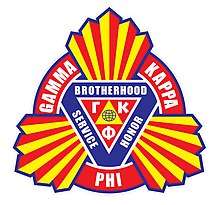 | |
| Founded | October 9, 1962 Divine Word College |
| Type | Service |
| Motto | There's No Such Thing As Failure |
| Symbol | 15 rays seal (general), "The High and the Mighty" (anthem) |
| Chapters | Provincial & City Alumni Councils Other International Councils: |
| Members | |
| Cardinal Principles | Brotherhood, Service, and Honor |
| Headquarters | Pasay, Metro Manila Philippines |
| Website | gammakappaphi |
History
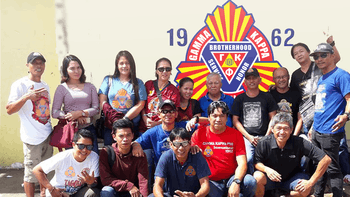
The organization was started as a group called G-Club or Gentlemen's Club by mostly liberal arts students of the school's College of Law. A professor of the College of Law, lawyer Rosemarie Beldia suggested the formation of Gamma Kappa Phi when she convinced her brother, Antonio Beldia III, to transform the club into a brotherhood or fraternity. Antonio called for a meeting with his fellow members and agreed to formally rename the G-Club into the Gamma Kappa Phi Fraternity with Vicente Baquial, Florante Cimagala, Alfonso Damalerio, Lauro Dominese, Landelino Maslog, Fernan Maslog, Romulo Racho, Godofredo Sinajon, Roldan Sarmiento and Prisco Viñalon, comprising the eleven founding members.
Historical conflicts
The Gamma Kappa Phi an organization was not free from certain issues of its history and organizational concerns that adversely affected it towards achieving its objectives. These answered all the woes that beset the organization during the last few decades by annual national conventions started in 1978, which was held the First National Convention in Dumaguete City and 1989 National Consultative Assembly in Cebu City. A research committee took off in December 2004 to resolve the conflicting history of the organization.
Founding year
The founding year of Gamma Kappa Phi was introduced by Silliman University chapter in 1977 as a conflicting difference earlier than 1962; by using the year '1952'. This was believed to be the work of a certain person, who falsely claimed as a member and deceived for recruiting new members to revive the chapter in 1977. The fact that Silliman University chapter was known to cease its operation in 1972 due to the implementation of Martial Law and the revival became a controversy. In addition to the controversy, the Silliman University Chapter sponsored the “First National Convention" in 1979 when the attendees who came from other provinces, especially in Mindanao were convinced on what founding year the chapter used. As a result, it was an influential to some attendees to introduce in the Visayas and Mindanao the wrong information they were convinced by the host chapter. However, some members believed that this was wrong, but other members had introduced to compete for their rivalry with other organizations as a mock of its longest period of existence. Eventually, it became an organized debate and conflict from members whose stand was to pursue using the wrong founding year that they had already introduced and advertised to the public. Another reason, the community values in their cultural milieu involve more than that – loss of face and loss of personal prestige. There were some individual and personal resistance, but more likely bordering on absurd logic on changing 1952 to 1962 was not merely a matter of “simple historical correction.” This became a question from the early generation members of 1969-70s in Silliman University and Central Mindanao University who have first known nothing about the founding year issue from members at other provinces. During this period of historical confusion, Gamma Kappa Phi in Cagayan de Oro was well history-oriented during the presence of one of the Founder Atty. Fernan Maslog who served as their adviser from 1978 to the 1980s. Cagayan de Oro City members were known to be the only followers of true 1962 founding year behind the entire nationwide members who were confused in adapting the mixed 1962 or 1952 founding year starting in 1977. Consequently, members in other parts of the Visayas and Northern Mindanao were more influenced in adapting the wrong founding year, but other chapters remain to follow the truth of the 1962 founding history. The breakthrough of this controversy reaches its height into a debated issue and the clamors for verification have been raised and strongly felt as early in 1978. The 2005 National Convention held in Cebu City had the research activity carried out and resolved this historical issue of the mistake in using the 1952 false founding year and corrected to its true and real founding year of Gamma Kappa Phi as 1962. But this issue remains the main organizational conflict, as members are still divided on certain issues, and the division is caused by different mindset and personal values, which are seemingly irreconcilable among members.
Manifesto
Because for many years, and up to present, the "Founding Year" remains a hotly debated among members. The official declaration of the founding date of "October 9, 1962", as a result of the Plenary Session proceedings of the 1st National Convention of 2005 in Cebu City, wherein the findings of the Historical Research Committee as presented, discussed and adopted, were not accepted by some sectors of the Fraternity, causing disunity, divisiveness, and ill-feelings amongst members. Finally, the Council of Living Founders and Pioneer Members declared and stand a Manifesto to declare their duty and obligation to bequeath a legacy of truth anchored on irrefutable and verifiable facts in order to settle the matter once and for all.[1]
Sorority designation name
After two years, a sorority named Gamma Sigma (not Gamma Kappa Sigma) was formed in 1964 and became a closed organization with the Gamma Kappa Phi Fraternity in Divine Word College, due to some blood relations by each member. Gamma Sigma Sorority just existed and went to its 'natural disappearance' as it was never reorganized again since its last active member. The Gamma Sigma Sorority connection with the Gamma Kappa Phi Fraternity was the reason of early members thought of 'Sigma' in adapting the 'Gamma Kappa Sigma' designation for the sorority. Gamma Kappa Phi was never known to use 'sigma' as a designation of sorority members when introduced in Mindanao in 1970 to the early 1980s. This was not known to use at the same time when it was introduced in Cebu City in 1974. But unknown by most of the members to its real story, 'Gamma Kappa Sigma' was only evolved to use as the forebearers name of the organization's sorority due to the Gamma Sigma sorority story. Using 'sigma' designation is totally inappropriate to consider as a fact of Gamma Kappa Phi history. Dr. Raymundo 'Chito' Luzano who was known as the legendary organizer of the first School Chapter of Cebu City in 1974 and who met earlier the founders and pioneers had clarified this controversial name for the sorority that convinced him to author the removal of 'sigma' designation spreading by other chapters. During the organization's 2006 National Constitutional Convention in Cagayan de Oro City, the 'Sigma' designation being used for sorority was overwhelmingly dropped by the members. This was formally cleared as all sorority and fraternity members within the organization have their only sole name as 'Gamma Kappa Phi' and not to use the Gamma Kappa Sigma for the sorority's designated name.
Expansion
In 1968, two members of Divine Word College who joined in 1965, Proculo Maslog and Idelfonso Sanchez, transferred their studies in Silliman University in Dumaguete City and organized it as the first school chapter in 1969 to operate outside the province. It was the Silliman University members who started to call itself as 'KAPPANS' and introduced the 15-rays seal in 1970, who designed and created by Daniel Villamena (a member of the second batch of pioneering members).
Evolution of the Gamma Kappa Phi seal

The first Fraternity seal was introduced during the same period of its foundation in 1962. This was designed in a circular form as used by members in an embroidered patch which was sewn on their shirt or a painted version in a cloth banner or plywood. Unfortunately, the circular design seal was not adopted to use when new members have spread outside the founding school in Divine Word College. Subsequently, a new form of the seal was created with another design from Silliman University Chapter which was organized in 1969 by Procolo Maslog and Idelfonso Sanchez who are both members of Divine Word College. Maslog and Sanchez have finally finished their studies and left the new members they recruited to serve as the new forerunners of the Gamma Kappa Phi fraternity. In the first semester of the school year in August 1970, the pioneering members of the 1969 Silliman Chapter led by Grand Noble Master Roger Valencia assigned Danilo Villamena to design a seal for their school chapter. The new seal design was first painted in a plywood size that was displayed in their booth on the occasion of the founding anniversary celebration of the school. It has a feature of ’15 rays’ that spread around its circular form which depicts the 15 pioneer members of 1969. The seal was unanimously approved by members to be used as the Gamma Kappa Phi seal designated for the Silliman University school chapter. In the following school semester, Reynaldo Pagalan who is among the pioneer member of 1969 has transferred his studies at Central Mindanao State University in Musuan, Bukidnon and organized Gamma Kappa Phi in the school. Consequently, he able to introduce the Silliman chapter seal, which in turn was also adapted to use by the Central Mindanao University school chapter.
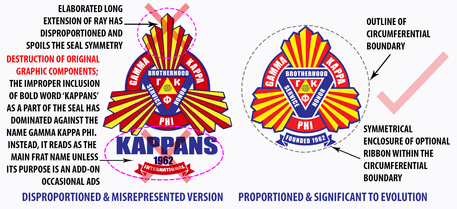
This was the beginning of the '15 rays' seal continued its circulation, which formally adopted to use by other new organized chapters. Eventually, the supposed '15 rays' Silliman University chapter seal became the official seal adopted by the entire Gamma Kappa Phi fraternity and sorority. However, during the early decade, members rely on hand drawings or manual process due to an expensive machine and technical printing. Likewise, this is the reason for early visual miscommunications to match its typical resemblance in every duplication. The mistake of, no matter how artistic it was drawn as long as the design is closer to one version to another has turned the staggering feature of the seal design. In addition, some artist's own versions of slim and long extended '15 rays' have disproportioned the seal design which became insignificant to the depiction of its historical evolution. Finally, the '15-rays' is considered as the 'forerunners' seal to the original founder's seal, which was created during its founding in 1962. Adapting the 15-rays seal is regarded as an 'accident' to use because of its history where it is supposedly intended as the chapter seal of Silliman University.
The Controversial Trademark Logo
A logo (not a seal) bearing a 'Gamma Kappa Phi + Kappans' (see its similarity with the disproportioned and misrepresented version image at upper right) is circulating and inappropriately claims a trademark registration. On the contrary, Gamma Kappa Phi is a non-profit organization to bear a trademark logo that would be chaotic as an organization to have a branding identity that would mean its engagement in trading and commercial business. In addition to poor quality in the geometric and graphics composition of the said trademark logo, it also defies the original feature of the seal's one piece legacy. Consequently, it depicts its controversy from protocol violation covertly performed by the creator and members who are promoting its use without convening the consent of the majority. To intervene in this repercussion, the one-piece traditional seal (not a logo) as shown at top right, was registered as an International Protected Copyright work with the Intellectual Property Rights Office (IPRO), Copyright Registration Service (CRS).
Journey towards expansion
The birth of the organization in Mindanao and Cebu
Reynaldo Pagalan, one of the pioneering members of the Silliman University Chapter in 1969, moved to Central Mindanao University (CMU) in Musuan, Maramag, Bukidnon. His journey to Mindanao as a student gave birth to the fraternity as the first school chapter in the Southern Philippines when he organized in 1970. He had not stayed long in CMU and transferred to Araneta University in Manila for his studies, while the members he left to continue the expansion and strengthening of the organization. Recruitment for new members followed, thus further spreading the organization to other parts of Mindanao when Paquito Omisol, who became a member in 1973, organized Mindanao State University Chapter in Marawi City in 1976, Diosdado Legara, who became a member in 1972, organized Xavier University – Ateneo de Cagayan chapter in Cagayan de Oro City in 1974, and Raymundo Luzano, Jr., who became a member of Xavier University Chapter in 1974, organized Velez College in Cebu City in 1975. These achievements include Proculo Maslog's organizing Silliman University Chapter in 1969, credited to them for the dramatic spread of the organization in southern and central Philippines during the late seventies honoring their designations to the 5 rays of the distinctive symbol and official seal of the organization. In later years and decades, the Fraternity and Sorority expanded throughout Philippine school chapters, nationwide, and spread its alumni members around the world and organized their based country councils.
The birth of the organization in Central and Northern Luzon
In 1978, Christino Lumanlan, Jr., who became a member in 1976 at the San Nicolas College in Surigao City, organized Holy Angel University Chapter in Angeles. Members expanded throughout Pampanga Province and eventually spread in Baguio City and other parts of Northern Luzon.
Alumni councils
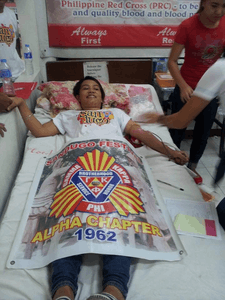
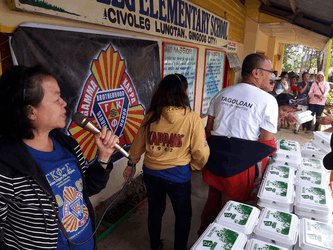
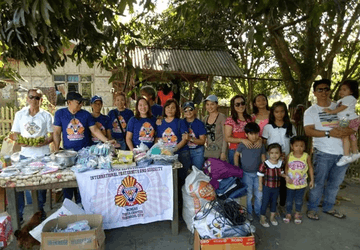
National alumni councils
Gamma Kappa Phi Alumni Councils nationwide has been participating in voluntary community service, donations, and assistance to children feeding programs in their regional chapters. Members have been attending quarterly participation of blood donations for their Bloodletting Activity with the Philippine Red Cross at Port Area Manila. Central and southern Philippine Alumni Councils were participants with the same bloodletting program in their municipality, city, province, and region, including participation in public events, community assistance, and cooperation in joining with non-government organization during calamity and natural disasters where they voluntarily serve.
International alumni councils
Gamma Kappa Phi is a registered non-profit organization in the City of Chicago, Illinois, United States of America. It is also registered as an international alumni association at Philippine Embassy in Riyadh, Kingdom of Saudi Arabia, with two councils in the Western region located in Jeddah and Eastern region in Riyadh. Other alumni councils are based in Canada, the United Arab Emirates, Qatar, the United Kingdom and Hongkong.
Conventions
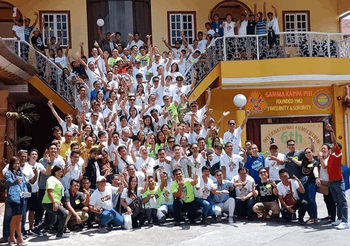
The Gamma Kappa Phi as a whole organization was not free from certain issues of its history and organizational concerns that adversely affected its achievement of noble objectives. With advancements in communications, (i.e., mobile phones, the Internet, the interconnection between individual members and the organization as a whole) discussions have been made easier which during the early years of the organization's history was virtually non-existent and so, therefore, resulted in a lot of misinformation regarding the group's history and organizational structure. This misinformation was further magnified because the organization continued to grow and spread all over the country with no central governing structure. Despite the fact, there were early attempts at holding national assemblies, most notably the 1978 National Convention in Dumaguete City and the 1989 National Consultative Assembly held in Cebu City. It was not until 2005 that a credible national assembly was finally organized. The 2005 National Convention held in Cebu City was brought about by the clamor from various individual members who were finally connecting with each other through the online social groups that were already becoming a norm at that time. With the Cebu-Iota Chapter taking the helm in the preparation of the National Convention, a research committee was formed in December 2004 to gather data, thresh out and verify all pertinent historical data and present it to the general membership at the National Convention, held on October 7–9, 2005.
The 2005 National Convention in Cebu City proved to be the first important and critical step towards formally forming an organization on the national and international levels. Since then, national gatherings have been held every two years with the venue and sponsor bid out during the preceding national gathering.
Gradual progress has been made to further gather, verify and collate data from all existing chapters and councils, not only in the Philippines but also in countries where members have moved for work or migrated.
Membership
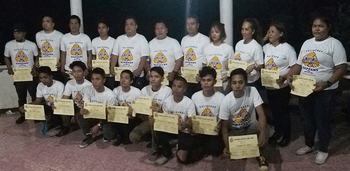
Gamma Kappa Phi members were admitted to the college as qualified students when they are duly enrolled at the tertiary level in college as the organization's mandatory requirement with irrespective of political affiliation, religion, race, citizenship, and good moral character. In the late 1970s, there is some controversy of High School students who were wrongly admitted to membership. However, they were considered 'Junior' members and later allowed to received full pledge membership once they pursue and fulfilled the required level in their college enrolment. Although this was a violation of the protocol based on their required recognition as a collegian; finally, when this act of negligence by these irresponsible members was rebuked, it totally banned a high school or secondary student admission or recruitment. Therefore, there is no such member in the Gamma Kappa Phi members roster who is known to be at the high school level. As far as the present information of its members, only a few are college dropouts who shifted to finish the technical course but a high percentage of being successful alumni and professionals. Generally, alumni members have obtained their tertiary-level degree, were accepted to honorary members who are distinguished in their career through personal merits which are approved by the body and members.
Government registration
Gamma Kappa Phi was officially registered to Securities and Exchange Commission (Philippines) as Gamma Kappa Phi International Inc. under a non-profit organization with registration number CN 201321651 and TIN 008-656-309 on November 12, 2013.
References
- "Gamma Kappa Phi Fraternity & Sorority". www.gammakappaphi.com.